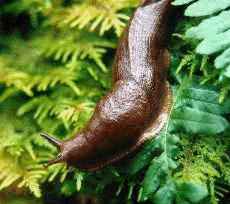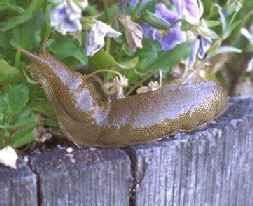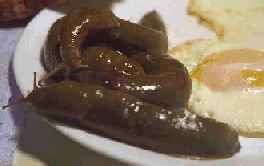Categories
Calendars
Guides
Reviews
Archive
Gallery
Articles
Ask Our Gardening Expert
How To Win The Slug War
Your vegetables and plants are slug paradise - wet winters combined with temperate wet
summers provide the ideal conditions for slugs. Their natural enemies,
weather-wise, are frosty winters and hot summers. Know Your Slug!
Another common slug you will meet looks a bit more of a monster - it can
be up to 15cm (6in) long and is called the 'black slug' because
of its colour. Many people assume that this is the slug which
is doing all the damage. In fact it causes very little damage to
your plants - it's the much smaller garden and field slugs which
cause all the damage. So the motto with slugs is 'ignore the big black ones'! There is a less common slug known as the keeled slug (Milax
budapestensis). It's about 10cm (4in) long and has a
definite ridge down its back. It's not as common as the other
slugs, but it does cause considerable damage. Organic Control Nematodes The idea is to buy them in plastic packages, put
them into a watering can, add water and then water the areas
affected by slugs. The little nematodes then enter the slugs and
release bacteria which slowly kills the slug. Even better news
is that the nematodes then multiply and go in search of more
slugs! It does work - farmers have been using them for several
years and are increasing their use of them each year. Click here to go to an in-depth article
written by Owen M., GardenAction's expert on green methods of
slug and pest control. Owen has been a professional in the pest
control industry for over 18 years and he knows almost all there
is to know about green pest control. Barriers The
100% barrier method that works for seedlings is a plastic bottle
with the base cut off. Insert it at least 10cm (4in) deep into
the soil around the seedling and only the most determined slug
will succeed - great as a cloche as well. The problem comes when
the seedlings outgrow the bottle. However, slugs really do
prefer the tastier younger plants. Another
plastic alternative is a band of flexible plastic placed
all around a number of plants - these are available from garden
centres. The plastic should be at least 30 cm (1ft) high; 10 cm
(4in) below ground and 20cm (8in) above ground. This doesn't
stop all slugs, but deters most. The problem here, is that slugs
may already be inside the plastic wall, and they won't be able
to get out. One common problem with barrier prevention is that you can apply
apply them too late in the season. Slugs are not stupid, especially when laying
eggs. They lay their eggs late in the year just under the soil near leaves which
have fallen to ground. They do this because they know that next spring it is likely
that new tasty plant shoots will appear. Placing barriers around prized plants in
spring will trap emerging young slugs exactly where you do NOT want them. So, the best plan is to clear the top soil around prized plants in
late October, replace it with clean soil. Then place the barrier around the plants.
This will remove the slug eggs from the soil around your plants rather than keep
them in the soil. Beer and Milk Traps Hand Collection At Night You may well find that a large number of slugs are on your lawn at
night, rather than directly on the soil. This raises the
interesting proposition of getting the lawn-mower out at
midnight and single handedly massacring thousands of slugs in
half an hour. Because of the obvious safety implications of
mowing the lawn at night, I have never done this myself.
However, a friend of a friend of ours tells us that it works a
treat! Chemical Control of Slugs Metaldehyde It kills slugs both on contact and when eaten by the slugs. The pellets consist of
around 5 % metaldehyde with the remaining 95% being designed to
attract slugs - pure metaldehyde will actually repel slugs.
Hence the reason for applying slug pellets sparingly - too many
in a small area will repel them, not kill them. The poison works
by causing the slugs to produce large amounts of mucus which
cause dehydration and prevent them from moving. The best time to use metaldehyde pellets is on a warm humid night when rain is not
expected the next day. The warm humid weather attracts the slugs
to the surface where they eat the pellets. They are then
prevented from moving by the mucus they extract, and the dry
conditions the next morning finishes them off. Shower resistant
pellets will remain effective over several days. Metaldehyde is poisonous to mammals so will damage or kill a wide variety of
useful garden animals. Avoid contact of the pellets with plants,
because they absorb the chemical into the crops we eat. For this
reason, metaldehyde spray (as opposed to pellets) is not
advisable at all for garden use. Metaldehyde tapes have been available for several years - they are sold as
coils of paper which should be laid on the soil near the
threatened plants. The slugs eat the tape (made to be tasty to
slugs) and also the metaldehyde. The advantage with the tape
method is that wildlife do not eat it and it is thus much more
'friendly' compared to pellets. Methiocarb Which Chemical To Use and Where? Aside from the arguments against chemicals in the garden however, ask
yourself this question - if slug pellets are designed to attract
slugs (and they are), do you really want to spread them around
your tender plants? In our view, they are much more effective if
they are sparingly spread in those areas of the garden where you
suspect the slugs are hiding during the day. A controversial
view, but read this paragraph again and think carefully. GO
TO THE GARDEN PEST AND DISEASE MAIN PAGE FOR
The most common slug is the garden slug ('Arion
hortensis' to be precise). It's grey or brown and only 4cm
(1.5in) long. It slithers around your garden on an orange sole.
Another slug you may may well meet is the field slug ('Derocerus
reticulatum'). This one is different from the garden slug
because it has distinct brown patches on its sides. Both slugs are
bad news for your tender plants and vegetables.
There are a variety of non-chemical solutions to slugs, some of
which are described below. Talk to gardeners in your area to
find out what they use.
 Nematodes
are the
latest and it seems the most effective way of controlling slugs,
this beats the chemical alternatives easily. Nematodes are tiny
organisms, so small they are invisible to the eye. They are
naturally occurring organisms which are harmless to you, your
kids, wildlife and your plants.
Nematodes
are the
latest and it seems the most effective way of controlling slugs,
this beats the chemical alternatives easily. Nematodes are tiny
organisms, so small they are invisible to the eye. They are
naturally occurring organisms which are harmless to you, your
kids, wildlife and your plants.
Scatter sharp material around the plants to prevent the slugs
getting too near them. Often used are soot, sand, ashes and
broken egg-shells. these definitely make it considerably more
difficult for slugs to get near the plants by drying up the
mucus which slugs rely on to move. All of them will be affected
by wind and rain, so frequent re-application is required. They
also suffer from the disadvantage that they do not lower the
number of slugs in the garden, although it may well encourage
them to take up residence in the neighbours garden instead!
Quarter fill a jam jars or any plastic container with either
milk or beer, and sink them into the ground so that they are
about 1 to 2 cm (half to one inch) above the soil level. The
slugs can easily climb this, but it will stop ground beetles
from entering them and drowning. This method definitely works,
although you need at least for jars per square metre (yard), and
they will need to be replenished every two or three days.
Easily the most effective - simply collect the slugs by hand (a
long needle on a stick can be used if you don't like touching
them) and transfer them to container of salt water. You will
need a torch to spot them - expect to kill roughly a hundred per
hour. Search on the lawn, paths and around tasty plants.
Slug pellets sold in the UK contain metaldehyde and / or methiocarb.
 Originally sold as a solid fuel, its ability to kill and
control slugs was
discovered by accident when farmers in France found dead slugs
around picnic sites where the fuel tablets had been discarded by tourists.
Originally sold as a solid fuel, its ability to kill and
control slugs was
discovered by accident when farmers in France found dead slugs
around picnic sites where the fuel tablets had been discarded by tourists.
 Ten times more poisonous to mammals than metaldehyde, it's a far
more dangerous chemical to have around the garden. In addition,
it is a very effective insecticide and therefore kills a far
wider variety of beneficial animal life than metaldehyde. It's
more costly than all other methods, and there is no real
evidence that it is more effective than metaldehyde.
Ten times more poisonous to mammals than metaldehyde, it's a far
more dangerous chemical to have around the garden. In addition,
it is a very effective insecticide and therefore kills a far
wider variety of beneficial animal life than metaldehyde. It's
more costly than all other methods, and there is no real
evidence that it is more effective than metaldehyde.
If you have to use chemicals to kill slugs, use metaldehyde and for
economic and successful results, use it sparingly.
PESTS AND DISEASES CLASSIFIED BY PLANT